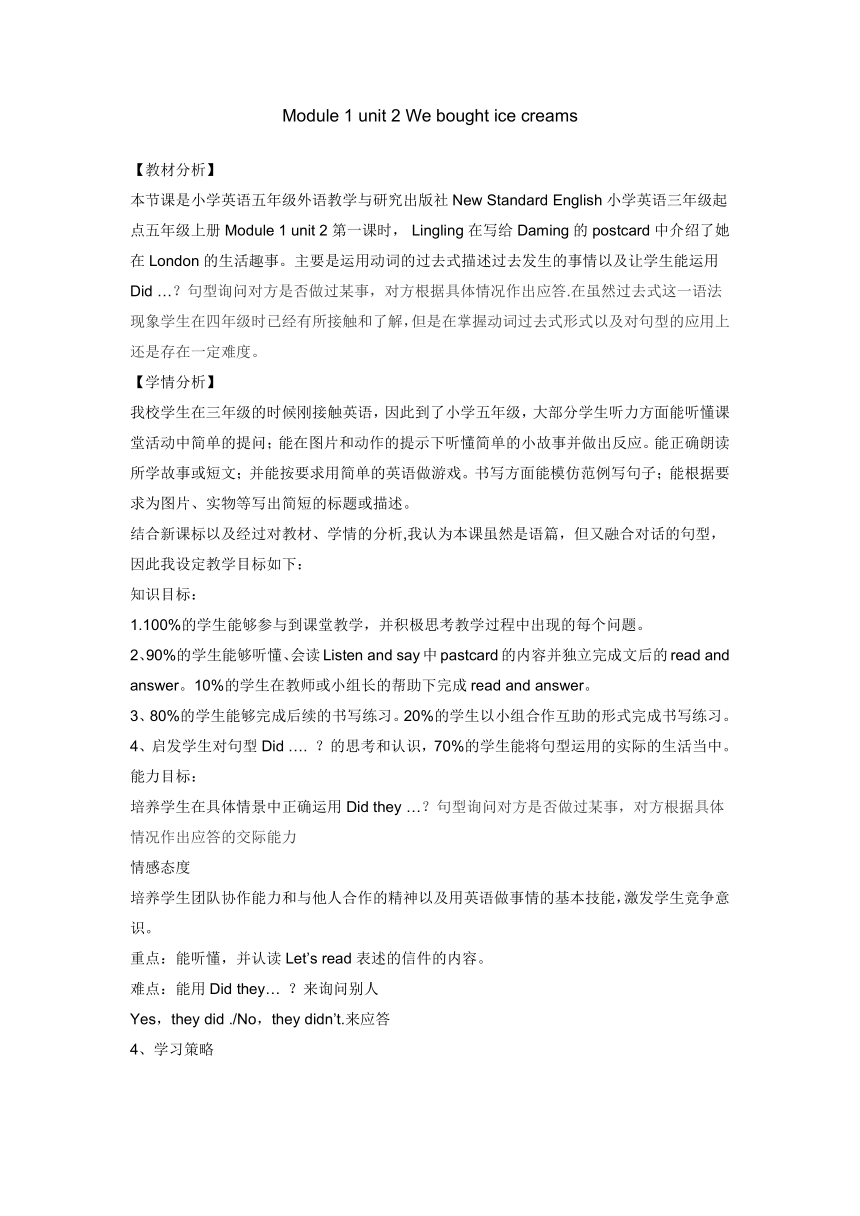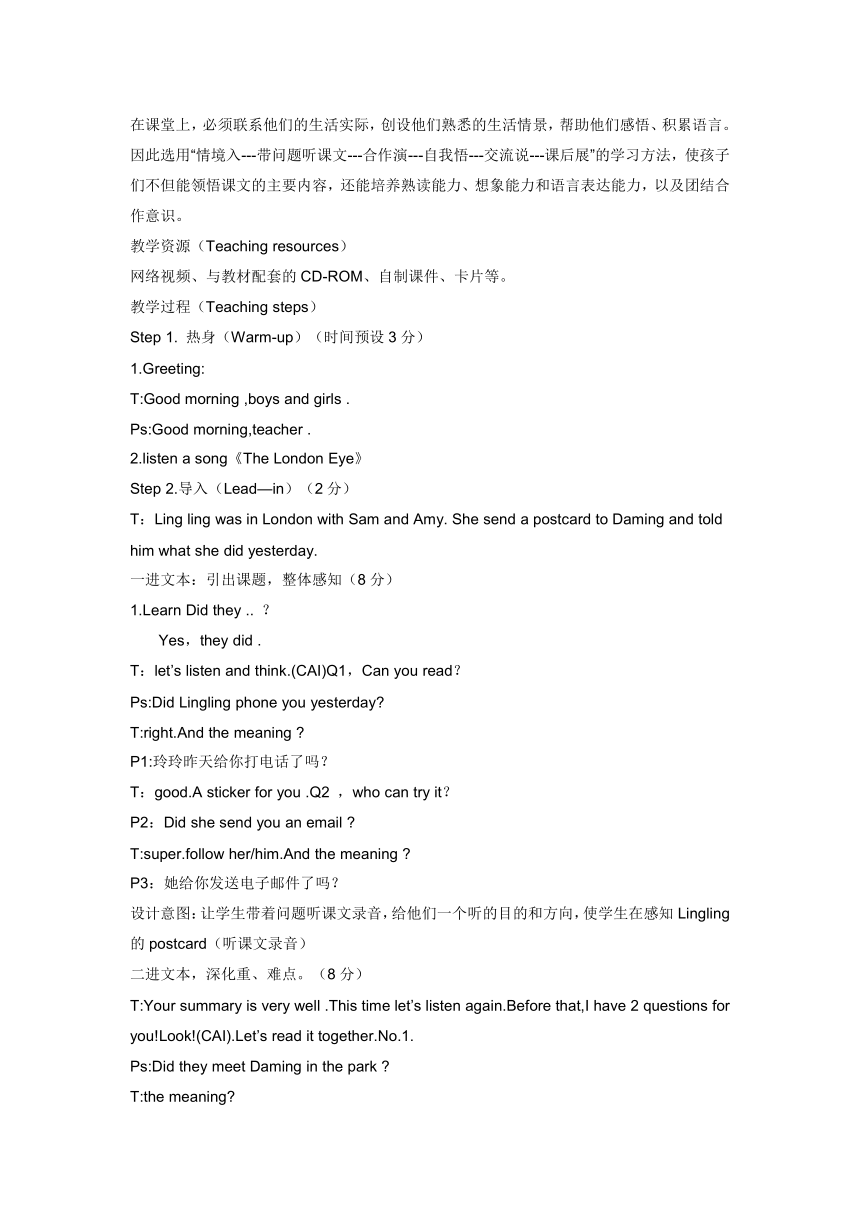Module 1 unit 2 We bought ice creams 教案
文档属性
| 名称 | Module 1 unit 2 We bought ice creams 教案 |  | |
| 格式 | zip | ||
| 文件大小 | 8.2KB | ||
| 资源类型 | 教案 | ||
| 版本资源 | 外研版(三年级起点) | ||
| 科目 | 英语 | ||
| 更新时间 | 2018-08-14 10:43:02 | ||
图片预览


文档简介
Module 1 unit 2 We bought ice creams
【教材分析】
本节课是小学英语五年级外语教学与研究出版社New Standard English小学英语三年级起点五年级上册Module 1 unit 2第一课时,?Lingling在写给Daming的postcard中介绍了她在London的生活趣事。主要是运用动词的过去式描述过去发生的事情以及让学生能运用Did …?句型询问对方是否做过某事,对方根据具体情况作出应答.在虽然过去式这一语法现象学生在四年级时已经有所接触和了解,但是在掌握动词过去式形式以及对句型的应用上还是存在一定难度。
【学情分析】
我校学生在三年级的时候刚接触英语,因此到了小学五年级,大部分学生听力方面能听懂课堂活动中简单的提问;能在图片和动作的提示下听懂简单的小故事并做出反应。能正确朗读所学故事或短文;并能按要求用简单的英语做游戏。书写方面能模仿范例写句子;能根据要求为图片、实物等写出简短的标题或描述。
结合新课标以及经过对教材、学情的分析,我认为本课虽然是语篇,但又融合对话的句型,因此我设定教学目标如下:
知识目标:
1.100%的学生能够参与到课堂教学,并积极思考教学过程中出现的每个问题。
2、90%的学生能够听懂、会读Listen and say中pastcard的内容并独立完成文后的read and answer。10%的学生在教师或小组长的帮助下完成read and answer。
3、80%的学生能够完成后续的书写练习。20%的学生以小组合作互助的形式完成书写练习。
4、启发学生对句型Did …. ?的思考和认识,70%的学生能将句型运用的实际的生活当中。
能力目标:
培养学生在具体情景中正确运用Did they …?句型询问对方是否做过某事,对方根据具体情况作出应答的交际能力
情感态度
培养学生团队协作能力和与他人合作的精神以及用英语做事情的基本技能,激发学生竞争意识。
重点:能听懂,并认读Let’s read表述的信件的内容。
难点:能用Did they… ?来询问别人
Yes,they did ./No,they didn’t.来应答
4、学习策略
在课堂上,必须联系他们的生活实际,创设他们熟悉的生活情景,帮助他们感悟、积累语言。因此选用“情境入---带问题听课文---合作演---自我悟---交流说---课后展”的学习方法,使孩子们不但能领悟课文的主要内容,还能培养熟读能力、想象能力和语言表达能力,以及团结合作意识。
教学资源(Teaching resources)
网络视频、与教材配套的CD-ROM、自制课件、卡片等。
教学过程(Teaching steps)
Step 1. 热身(Warm-up)(时间预设3分)
1.Greeting:
T:Good morning ,boys and girls .
Ps:Good morning,teacher .
2.listen a song《The London Eye》
Step 2.导入(Lead —in)(2分)
T:Ling ling was in London with Sam and Amy. She send a postcard to Daming and told him what she did yesterday.
一进文本:引出课题,整体感知(8分)
1.Learn Did they .. ?
????? Yes,they did .
T:let’s listen and think.(CAI)Q1,Can you read?
Ps:Did Lingling phone you yesterday?
T:right.And the meaning ?
P1:玲玲昨天给你打电话了吗?
T:good.A sticker for you .Q2 ,who can try it?
P2:Did she send you an email ?????
T:super.follow her/him.And the meaning ?
P3:她给你发送电子邮件了吗?
设计意图:让学生带着问题听课文录音,给他们一个听的目的和方向,使学生在感知Lingling的postcard(听课文录音)
二进文本,深化重、难点。(8分)
T:Your summary is very well .This time let’s listen again.Before that,I have 2 questions for you!Look!(CAI).Let’s read it together.No.1.
Ps:Did they meet Daming in the park ??????????
T:the meaning?
P1:他们遇见大明了吗?
T:No.2,please.
Ps:Did they walk to the bus ?
T:the meaning ?
P2:他们走着上公车吗?
设计意图:引导学生围绕问题Did they.. ?来猜测,而且带着自己猜测的可能答案去听录音,把文字阅读变为印证活动。学生通过思考和猜测这几个问题的答案再进行阅读能增强他们阅读文章的自信心。
T:I think you can understand these questions.Listen carefully!
(播放录音)
1.Learn Did 引导的问句的否定回答
T:Answer my question:Did they meet Daming in the park?
P1:No.
T:No is ok .but?our ?expression to complete
“?No,they didn’t.”板书Again!
(work in pairs.two by two)板书 meet
T:They din’t meet Daming .Who did they meet ?
2.通过问题Who did they meet?来学习meet 的过去式met的读音
Ps:John.
T:yes.Let’s read the sentence .They met John in the park . Pay attention this word“ met” (pet-met)
Group by group
师板书?They met John in the park.
3.通过How did they go to the bus?来学习run 的过去式ran的读音
同样方法处理Q2
T:What did you learn ?
P1:they met John in the park
P2:They ran to the bus.
设计意图:通过What did you learn?让学生自己小结出they met John in the park
They ran to the bus.让学生进一步从整体上把握课文脉络,理解课文大意,使学生对文章内容和结构有一个整体印象。
T:super!Let’s go on talking about this postcard .This time read it?by yourself,then choose the answer.OK?
三进文本,细读赏析(4分)
Listen and choose.
设计意图:引导学生细读短文、理解短文,并设计一些练习让学生完成,以检测学生的理解程度。同时也是对课文整体的回顾。
?
1.We?????????:wentto the park yesterday.???? A:came????? B
2.We??????????:met????? B:droppedJohn.????????? ??????????A
3.We?????????:walked???? B:ran?to the bus .????????????? ?A
4.We??????????:bought???????? B:atethe?icecreams.?????????? A
?
T:Let’s check the answer.
(学生把答案说出来后,把整个句子读一遍 )
Step 3 :听读课文(3分)
1.Listen point and say
2.Read it by yourself ,If you have questions ,you can ask me or your pattern.
3.read it together.
?? ?在学生学完知识点回归课文时,我设计了三步读课文,一是跟读原声带,目的是为了让学生纠正语音语调,二是学生自读,发现问题可以问老师或同学,这个过程可以让学生将所学课文慢慢内化,三是齐读,为后面的复述课文做准备。
Step 5 :拓展
1.T: T:Send a postcard to me or your friends.Pay attentation the postcard form whom to whom .And you can use these points.OK?(课件)
2.T:Hello,boys and girls.The girl had finish it.Let’s listen carefully,then I will ask you some questions.Now listen,please.
(学生朗读他自己写的信,老师随机提出问题,挑学生回答,并且让读信的同学评价答案的正确与否,同时发放奖品)
在教授完课文以后,除了指导学生达到基本的能力培养目标,还设计了拔高性的练习,使学生的能力得到进一步发展。让学生回想自己的周末做了什么,以信的形式写出来,然后学生间进行交流,教师随机针对学生所写内容用Did he/she… ?来提问,让学生根据该生所写内容进行回答,既巩固了文章内容训练了学生的写作和理解能力又发挥了学生的参与意识,激发了学生的兴趣。
Step 6:Summary
T:What did you learn?
1.read these sentences(齐读板书)
2.(学生自己总结自己的收获)
一个不善于归纳总结的学生,他对课堂知识的印象就容易停留在感性认识层面上,而缺乏一种深层次的理性认识让学生回顾一节课的内容,通过小结能提高学生的综合概括能力,清晰地回忆出本课的要点。小学生虽然表达能力有限,但只需正确引导,学生便能正确地概括。
Step 7 :
T:Homework for you.After class,you can go on finishing the postcard.We’ll communicate next class.
T:Class is over.thank you for your listening.Bye!
???这个作业是对拓展环节的一个延伸,由于学生的学习水平有差异,因此,拓展环节的书信练习有很多学生没能完成,将其延伸到下一堂课的课前三分钟Free talk,给学生提供了更广的思考空间。
????????????????????????
?
板书设计
Did they buy ice creams? Yes,they did .???????? ????????No,they didn’t.
go to the park??????
?walk to bus
?meet????????
?We ran to the bus
【教材分析】
本节课是小学英语五年级外语教学与研究出版社New Standard English小学英语三年级起点五年级上册Module 1 unit 2第一课时,?Lingling在写给Daming的postcard中介绍了她在London的生活趣事。主要是运用动词的过去式描述过去发生的事情以及让学生能运用Did …?句型询问对方是否做过某事,对方根据具体情况作出应答.在虽然过去式这一语法现象学生在四年级时已经有所接触和了解,但是在掌握动词过去式形式以及对句型的应用上还是存在一定难度。
【学情分析】
我校学生在三年级的时候刚接触英语,因此到了小学五年级,大部分学生听力方面能听懂课堂活动中简单的提问;能在图片和动作的提示下听懂简单的小故事并做出反应。能正确朗读所学故事或短文;并能按要求用简单的英语做游戏。书写方面能模仿范例写句子;能根据要求为图片、实物等写出简短的标题或描述。
结合新课标以及经过对教材、学情的分析,我认为本课虽然是语篇,但又融合对话的句型,因此我设定教学目标如下:
知识目标:
1.100%的学生能够参与到课堂教学,并积极思考教学过程中出现的每个问题。
2、90%的学生能够听懂、会读Listen and say中pastcard的内容并独立完成文后的read and answer。10%的学生在教师或小组长的帮助下完成read and answer。
3、80%的学生能够完成后续的书写练习。20%的学生以小组合作互助的形式完成书写练习。
4、启发学生对句型Did …. ?的思考和认识,70%的学生能将句型运用的实际的生活当中。
能力目标:
培养学生在具体情景中正确运用Did they …?句型询问对方是否做过某事,对方根据具体情况作出应答的交际能力
情感态度
培养学生团队协作能力和与他人合作的精神以及用英语做事情的基本技能,激发学生竞争意识。
重点:能听懂,并认读Let’s read表述的信件的内容。
难点:能用Did they… ?来询问别人
Yes,they did ./No,they didn’t.来应答
4、学习策略
在课堂上,必须联系他们的生活实际,创设他们熟悉的生活情景,帮助他们感悟、积累语言。因此选用“情境入---带问题听课文---合作演---自我悟---交流说---课后展”的学习方法,使孩子们不但能领悟课文的主要内容,还能培养熟读能力、想象能力和语言表达能力,以及团结合作意识。
教学资源(Teaching resources)
网络视频、与教材配套的CD-ROM、自制课件、卡片等。
教学过程(Teaching steps)
Step 1. 热身(Warm-up)(时间预设3分)
1.Greeting:
T:Good morning ,boys and girls .
Ps:Good morning,teacher .
2.listen a song《The London Eye》
Step 2.导入(Lead —in)(2分)
T:Ling ling was in London with Sam and Amy. She send a postcard to Daming and told him what she did yesterday.
一进文本:引出课题,整体感知(8分)
1.Learn Did they .. ?
????? Yes,they did .
T:let’s listen and think.(CAI)Q1,Can you read?
Ps:Did Lingling phone you yesterday?
T:right.And the meaning ?
P1:玲玲昨天给你打电话了吗?
T:good.A sticker for you .Q2 ,who can try it?
P2:Did she send you an email ?????
T:super.follow her/him.And the meaning ?
P3:她给你发送电子邮件了吗?
设计意图:让学生带着问题听课文录音,给他们一个听的目的和方向,使学生在感知Lingling的postcard(听课文录音)
二进文本,深化重、难点。(8分)
T:Your summary is very well .This time let’s listen again.Before that,I have 2 questions for you!Look!(CAI).Let’s read it together.No.1.
Ps:Did they meet Daming in the park ??????????
T:the meaning?
P1:他们遇见大明了吗?
T:No.2,please.
Ps:Did they walk to the bus ?
T:the meaning ?
P2:他们走着上公车吗?
设计意图:引导学生围绕问题Did they.. ?来猜测,而且带着自己猜测的可能答案去听录音,把文字阅读变为印证活动。学生通过思考和猜测这几个问题的答案再进行阅读能增强他们阅读文章的自信心。
T:I think you can understand these questions.Listen carefully!
(播放录音)
1.Learn Did 引导的问句的否定回答
T:Answer my question:Did they meet Daming in the park?
P1:No.
T:No is ok .but?our ?expression to complete
“?No,they didn’t.”板书Again!
(work in pairs.two by two)板书 meet
T:They din’t meet Daming .Who did they meet ?
2.通过问题Who did they meet?来学习meet 的过去式met的读音
Ps:John.
T:yes.Let’s read the sentence .They met John in the park . Pay attention this word“ met” (pet-met)
Group by group
师板书?They met John in the park.
3.通过How did they go to the bus?来学习run 的过去式ran的读音
同样方法处理Q2
T:What did you learn ?
P1:they met John in the park
P2:They ran to the bus.
设计意图:通过What did you learn?让学生自己小结出they met John in the park
They ran to the bus.让学生进一步从整体上把握课文脉络,理解课文大意,使学生对文章内容和结构有一个整体印象。
T:super!Let’s go on talking about this postcard .This time read it?by yourself,then choose the answer.OK?
三进文本,细读赏析(4分)
Listen and choose.
设计意图:引导学生细读短文、理解短文,并设计一些练习让学生完成,以检测学生的理解程度。同时也是对课文整体的回顾。
?
1.We?????????:wentto the park yesterday.???? A:came????? B
2.We??????????:met????? B:droppedJohn.????????? ??????????A
3.We?????????:walked???? B:ran?to the bus .????????????? ?A
4.We??????????:bought???????? B:atethe?icecreams.?????????? A
?
T:Let’s check the answer.
(学生把答案说出来后,把整个句子读一遍 )
Step 3 :听读课文(3分)
1.Listen point and say
2.Read it by yourself ,If you have questions ,you can ask me or your pattern.
3.read it together.
?? ?在学生学完知识点回归课文时,我设计了三步读课文,一是跟读原声带,目的是为了让学生纠正语音语调,二是学生自读,发现问题可以问老师或同学,这个过程可以让学生将所学课文慢慢内化,三是齐读,为后面的复述课文做准备。
Step 5 :拓展
1.T: T:Send a postcard to me or your friends.Pay attentation the postcard form whom to whom .And you can use these points.OK?(课件)
2.T:Hello,boys and girls.The girl had finish it.Let’s listen carefully,then I will ask you some questions.Now listen,please.
(学生朗读他自己写的信,老师随机提出问题,挑学生回答,并且让读信的同学评价答案的正确与否,同时发放奖品)
在教授完课文以后,除了指导学生达到基本的能力培养目标,还设计了拔高性的练习,使学生的能力得到进一步发展。让学生回想自己的周末做了什么,以信的形式写出来,然后学生间进行交流,教师随机针对学生所写内容用Did he/she… ?来提问,让学生根据该生所写内容进行回答,既巩固了文章内容训练了学生的写作和理解能力又发挥了学生的参与意识,激发了学生的兴趣。
Step 6:Summary
T:What did you learn?
1.read these sentences(齐读板书)
2.(学生自己总结自己的收获)
一个不善于归纳总结的学生,他对课堂知识的印象就容易停留在感性认识层面上,而缺乏一种深层次的理性认识让学生回顾一节课的内容,通过小结能提高学生的综合概括能力,清晰地回忆出本课的要点。小学生虽然表达能力有限,但只需正确引导,学生便能正确地概括。
Step 7 :
T:Homework for you.After class,you can go on finishing the postcard.We’ll communicate next class.
T:Class is over.thank you for your listening.Bye!
???这个作业是对拓展环节的一个延伸,由于学生的学习水平有差异,因此,拓展环节的书信练习有很多学生没能完成,将其延伸到下一堂课的课前三分钟Free talk,给学生提供了更广的思考空间。
????????????????????????
?
板书设计
Did they buy ice creams? Yes,they did .???????? ????????No,they didn’t.
go to the park??????
?walk to bus
?meet????????
?We ran to the bus
同课章节目录
- Module 1
- Unit 1 Did you come back yesterday?
- Unit 2 We bought ice creams.
- Module 2
- Unit 1 What did you buy?
- Unit 2 How much cheese did you buy?
- Module 3
- Unit 1 Where did you go?
- Unit 2 Daming took a photo of his father.
- Module 4
- Unit 1 Mum bought a new T-shirt for me.
- Unit 2 What's the matter with Daming?
- Module 5
- Unit 1 There are only nineteen crayons
- Unit 2 There are forty.
- Module 6
- Unit 1 You can play football well.
- Unit 2 He ran very fast.
- Module 7
- Unit 1 He can't see.
- Unit 2 This little girl can't walk.
- Module 8
- Unit 1 What time does your school start?
- Unit 2 Yesterday I went to Sam and Amy's school.
- Module 9
- Unit 1 Are you feeling bored?
- Unit 2 I feel happy.
- Review Module
- Unit 1
- Unit 2
- Module 10
- Unit 1 He was in the kitchen.
- Unit 2 Don't shout, please!
- 旧版资料
- Module 1 London
- Module 2 Shopping
- Module 3 At the Weekend
- Module 4 Possession
- Module 5 In Class
- Module 6 Self-assessment
- Module 7 Community
- Module 8 School
- Module 9 Feelings
- Module 10 Manners
- Review Module
